Time-Transgressive Onset of Holocene Climate Optimum in Arid Central Asia and Its Association with Cultural Exchanges
Abstract
1. Introduction
2. Date and Methods
2.1. Study Area
2.2. Collection of Paleoclimatic Records
2.3. Interpretations of Paleoclimatic Proxies
2.3.1. Lake Sediments (Mainly Pollen and Quantitatively Reconstructed Precipitation)
2.3.2. Loess–Paleosoal Sections
2.3.3. Speleothems
3. Results and Discussion
3.1. The Spatial Difference in the Onsets of HCOs in ACA
3.2. The Impact of the Time-Transgressive Onset of the HCO on Cultural Exchange
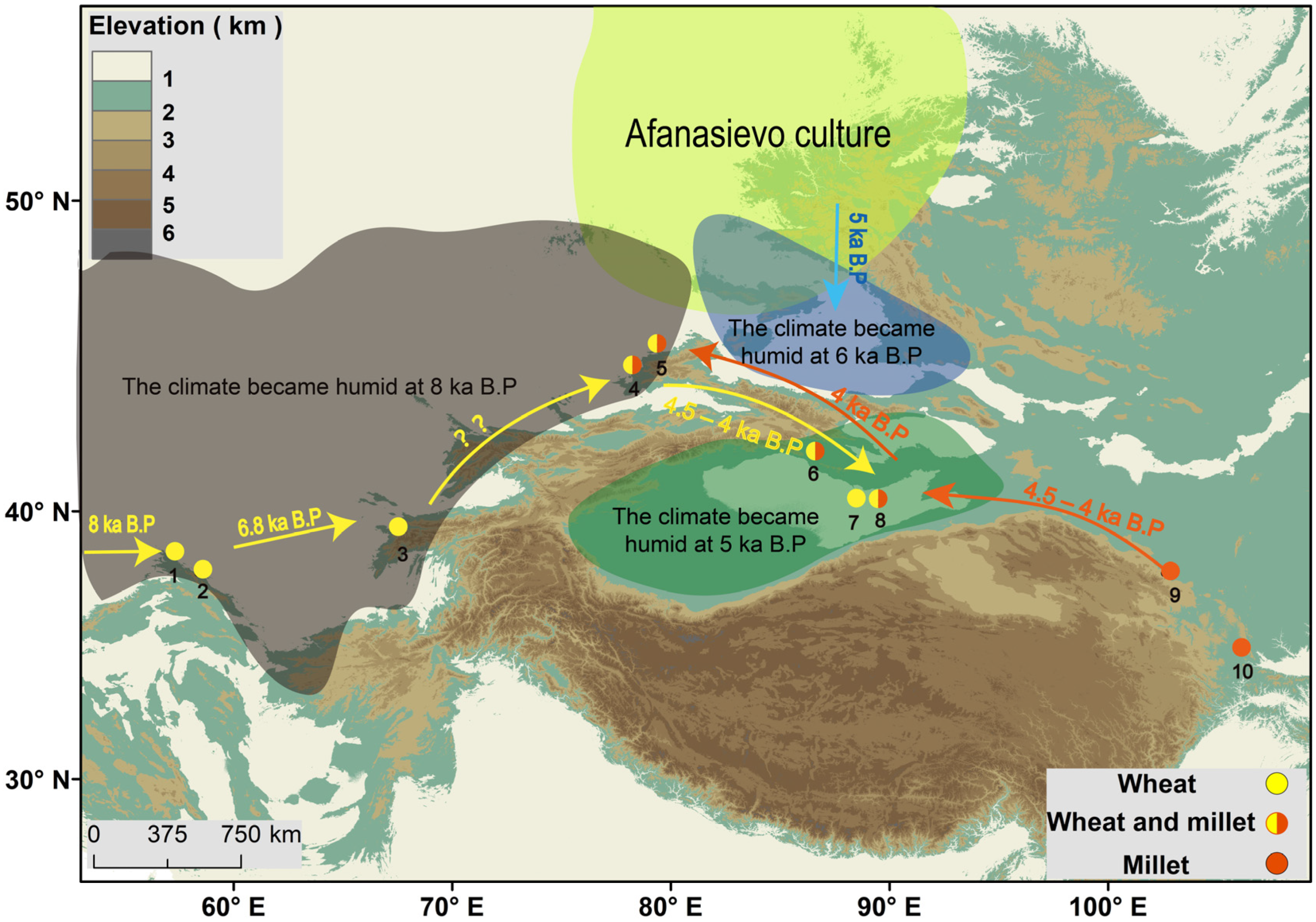
3.3. The Forcing Mechanism of the Time-Transgressive Onset of the HCO in ACA
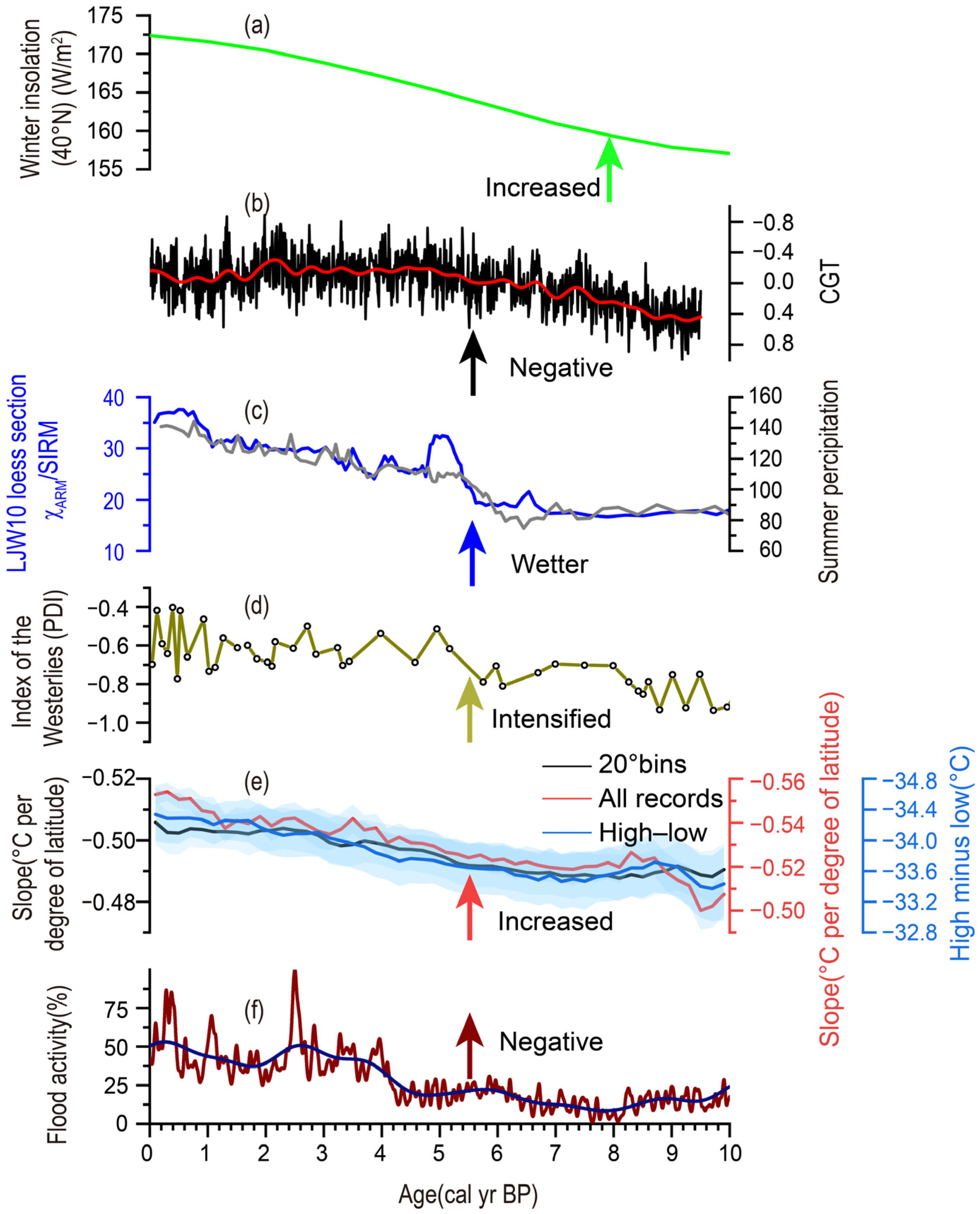
4. Conclusions and Perspectives
Author Contributions
Funding
Institutional Review Board Statement
Informed Consent Statement
Data Availability Statement
Conflicts of Interest
References
- Christian, D. Silk roads or steppe roads? The silk roads in world history. J. World Hist. 2000, 11, 1–26. [Google Scholar] [CrossRef]
- Kuzmina, E.E. The Prehistory of the Silk Road; University of Pennsylvania Press: Philadelphia, PA, USA, 2008. [Google Scholar]
- Dong, G.; Wang, L.; Zhang, D.D.; Liu, F.; Cui, Y.; Li, G.; Shi, Z.; Chen, F. Climate-driven desertification and its implications for the ancient Silk Road trade. Clim. Past 2021, 17, 1395–1407. [Google Scholar] [CrossRef]
- Wilmshurst, J.M.; McGlone, M.S.; Leathwick, J.R.; Newnham, R.M. A pre-deforestation pollen-climate calibration model for New Zealand and quantitative temperature reconstructions for the past 18 000 years BP. J. Quat. Sci. Publ. Quat. Res. Assoc. 2007, 22, 535–547. [Google Scholar] [CrossRef]
- Chase, M.; Bleskie, C.; Walker, I.R.; Gavin, D.G.; Hu, F.S. Midge-inferred Holocene summer temperatures in southeastern British Columbia, Canada. Palaeogeogr. Palaeoclimatol. Palaeoecol. 2008, 257, 244–259. [Google Scholar] [CrossRef]
- Ortega-Rosas, C.; Guiot, J.; Penalba, M.; Ortiz-Acosta, M. Biomization and quantitative climate reconstruction techniques in northwestern Mexico—With an application to four Holocene pollen sequences. Glob. Planet. Chang. 2008, 61, 242–266. [Google Scholar] [CrossRef]
- Loomis, S.E.; Russell, J.M.; Ladd, B.; Street-Perrott, F.A.; Damsté, J.S.S. Calibration and application of the branched GDGT temperature proxy on East African lake sediments. Earth Planet. Sci. Lett. 2012, 357, 277–288. [Google Scholar] [CrossRef]
- Tóth, M.; Magyari, E.K.; Buczkó, K.; Braun, M.; Panagiotopoulos, K.; Heiri, O. Chironomid-inferred Holocene temperature changes in the South Carpathians (Romania). Holocene 2015, 25, 569–582. [Google Scholar] [CrossRef]
- Liu, S.; Deng, C.; Xiao, J.; Li, J.; Paterson, G.A.; Chang, L.; Yi, L.; Qin, H.; Pan, Y.; Zhu, R. Insolation driven biomagnetic response to the Holocene Warm Period in semi-arid East Asia. Sci. Rep. 2015, 5, 8001. [Google Scholar] [CrossRef]
- Liu, X.; Zhan, T.; Zhou, X.; Wu, H.; Li, Q.; Zhao, C.; Qiao, Y.; Jiang, S.; Tu, L.; Ma, Y. Late onset of the Holocene rainfall maximum in northeastern China inferred from a pollen record from the sediments of Tianchi Crater Lake. Quat. Res. 2019, 92, 133–145. [Google Scholar] [CrossRef]
- Fohlmeister, J.; Schröder-Ritzrau, A.; Scholz, D.; Spötl, C.; Riechelmann, D.F.C.; Mudelsee, M.; Wackerbarth, A.; Gerdes, A.; Riechelmann, S.; Immenhauser, A.; et al. Bunker Cave stalagmites: An archive for central European Holocene climate variability. Clim. Past 2012, 8, 1751–1764. [Google Scholar] [CrossRef]
- Baxter, A.J.; Verschuren, D.; Peterse, F.; Miralles, D.G.; Martin-Jones, C.M.; Maitituerdi, A.; Van der Meeren, T.; Van Daele, M.; Lane, C.S.; Haug, G.H.; et al. Reversed Holocene temperature-moisture relationship in the Horn of Africa. Nature 2023, 620, 336–343. [Google Scholar] [CrossRef]
- Bernal, J.P.; Cruz, F.W.; Stríkis, N.M.; Wang, X.; Deininger, M.; Catunda, M.C.A.; Ortega-Obregón, C.; Cheng, H.; Edwards, R.L.; Auler, A.S. High-resolution Holocene South American monsoon history recorded by a speleothem from Botuverá Cave, Brazil. Earth Planet. Sci. Lett. 2016, 450, 186–196. [Google Scholar] [CrossRef]
- An, Z.; Porter, S.C.; Kutzbach, J.E.; Xihao, W.; Suming, W.; Xiaodong, L.; Xiaoqiang, L.; Weijian, Z. Asynchronous Holocene optimum of the East Asian monsoon. Quat. Sci. Rev. 2000, 19, 743–762. [Google Scholar] [CrossRef]
- Wang, Y.; Liu, X.; Herzschuh, U. Asynchronous evolution of the Indian and East Asian Summer Monsoon indicated by Holocene moisture patterns in monsoonal central Asia. Earth-Sci. Rev. 2010, 103, 135–153. [Google Scholar] [CrossRef]
- Chen, F.; Xu, Q.; Chen, J.; Birks, H.J.B.; Liu, J.; Zhang, S.; Jin, L.; An, C.; Telford, R.J.; Cao, X. East Asian summer monsoon precipitation variability since the last deglaciation. Sci. Rep. 2015, 5, 11186. [Google Scholar] [CrossRef]
- Chen, F.; Chen, J.; Huang, W.; Chen, S.; Huang, X.; Jin, L.; Jia, J.; Zhang, X.; An, C.; Zhang, J. Westerlies Asia and monsoonal Asia: Spatiotemporal differences in climate change and possible mechanisms on decadal to sub-orbital timescales. Earth-Sci. Rev. 2019, 192, 337–354. [Google Scholar] [CrossRef]
- Lu, H.; Yang, X.; Ye, M.; Liu, K.-B.; Xia, Z.; Ren, X.; Cai, L.; Wu, N.; Liu, T.-S. Millet noodles in late Neolithic China. Nature 2005, 437, 967–968. [Google Scholar] [CrossRef] [PubMed]
- Qiu, M.; Liu, R.; Li, X.; Du, L.; Ruan, Q.; Pollard, A.M.; Zhang, S.; Yuan, X.; Liu, F.; Li, G. Earliest systematic coal exploitation for fuel extended to ~3600 BP. Sci. Adv. 2023, 9, eadh0549. [Google Scholar] [CrossRef] [PubMed]
- Zhang, S.; Liu, H.; Li, G.; Zhang, Z.; Chen, X.; Shi, Z.; Zhou, A.; Dong, G.; Moran, E. Warfare impact overtakes climate-controlled fires in the eastern Silk Roads since 2000 B.P. Proc. Natl. Acad. Sci. USA Nexus 2023, 2, pgad408. [Google Scholar] [CrossRef]
- Qin, X.; Liu, J.; Jia, H.; Lu, H.; Xia, X.; Zhou, L.; Mu, G.; Xu, Q.; Jiao, Y.J.T.H. New evidence of agricultural activity and environmental change associated with the ancient Loulan kingdom, China, around 1500 years ago. Holocene 2012, 22, 53–61. [Google Scholar] [CrossRef]
- Liu, Z.; Zhu, J.; Rosenthal, Y.; Zhang, X.; Otto-Bliesner, B.L.; Timmermann, A.; Smith, R.S.; Lohmann, G.; Zheng, W.; Elison Timm, O. The Holocene temperature conundrum. Proc. Natl. Acad. Sci. USA 2014, 111, E3501–E3505. [Google Scholar] [CrossRef]
- Bader, J.; Jungclaus, J.; Krivova, N.; Lorenz, S.; Maycock, A.; Raddatz, T.; Schmidt, H.; Toohey, M.; Wu, C.J.; Claussen, M. Global temperature modes shed light on the Holocene temperature conundrum. Nat. Commun. 2020, 11, 4726. [Google Scholar] [CrossRef]
- Chen, F.; Duan, Y.; Hao, S.; Chen, J.; Feng, X.; Hou, J.; Cao, X.; Zhang, X.; Zhou, T. Holocene thermal maximum mode versus the continuous warming mode: Problems of data-model comparisons and future research prospects. Sci. China Earth Sci. 2023, 66, 1683–1701. [Google Scholar] [CrossRef]
- Chen, F.; Yu, Z.; Yang, M.; Ito, E.; Wang, S.; Madsen, D.B.; Huang, X.; Zhao, Y.; Sato, T.; Birks, H.J.B. Holocene moisture evolution in arid central Asia and its out-of-phase relationship with Asian monsoon history. Quat. Sci. Rev. 2008, 27, 351–364. [Google Scholar] [CrossRef]
- Jin, L.; Schneider, B.; Park, W.; Latif, M.; Khon, V.; Zhang, X. The spatial–temporal patterns of Asian summer monsoon precipitation in response to Holocene insolation change: A model-data synthesis. Quat. Sci. Rev. 2014, 85, 47–62. [Google Scholar] [CrossRef]
- Gao, F.; Jia, J.; Xia, D.; Lu, C.; Lu, H.; Wang, Y.; Liu, H.; Ma, Y.; Li, K. Asynchronous Holocene Climate Optimum across mid-latitude Asia. Palaeogeogr. Palaeoclimatol. Palaeoecol. 2019, 518, 206–214. [Google Scholar] [CrossRef]
- Liu, X.; Liu, J.; Shen, C.-C.; Yang, Y.; Chen, J.; Chen, S.; Wang, X.; Wu, C.-C.; Chen, F. Inconsistency between records of δ18O and trace element ratios from stalagmites: Evidence for increasing mid–late Holocene moisture in arid central Asia. Holocene 2020, 30, 369–379. [Google Scholar] [CrossRef]
- Dong, G.; Yang, Y.; Han, J.; Wang, H.; Chen, F. Exploring the history of cultural exchange in prehistoric Eurasia from the perspectives of crop diffusion and consumption. Sci. China Earth Sci. 2017, 60, 1110–1123. [Google Scholar] [CrossRef]
- Dong, G.; Li, R.; Lu, M.; Zhang, D.; James, N. Evolution of human–environmental interactions in China from the Late Paleolithic to the Bronze Age. Prog. Phys. Geogr. Earth Environ. 2020, 44, 233–250. [Google Scholar] [CrossRef]
- Yang, L.; Guan, X.; Zhang, Y. Atmospheric Circulation Characteristics of Precipitation Anomaly in Arid Regions in Central Asia. Arid. Zone Res. 2018, 35, 249–259. (In Chinese) [Google Scholar] [CrossRef]
- Aizen, E.M.; Aizen, V.B.; Melack, J.M.; Nakamura, T.; Ohta, T. Precipitation and atmospheric circulation patterns at mid-latitudes of Asia. Int. J. Climatol. J. R. Meteorol. Soc. 2001, 21, 535–556. [Google Scholar] [CrossRef]
- Hu, Z.; Zhou, Q.; Chen, X.; Qian, C.; Wang, S.; Li, J. Variations and changes of annual precipitation in Central Asia over the last century. Int. J. Climatol. 2017, 37, 157–170. [Google Scholar] [CrossRef]
- Guan, X.; Yang, L.; Zhang, Y.; Li, J. Spatial distribution, temporal variation, and transport characteristics of atmospheric water vapor over Central Asia and the arid region of China. Glob. Planet. Chang. 2019, 172, 159–178. [Google Scholar] [CrossRef]
- Chen, S.; Chen, J.; Lv, F.; Liu, X.; Huang, W.; Wang, T.; Liu, J.; Hou, J.; Chen, F. Holocene moisture variations in arid central Asia: Reassessment and reconciliation. Quat. Sci. Rev. 2022, 297, 107821. [Google Scholar] [CrossRef]
- Hu, Y.; Huang, X.; Demberel, O.; Zhang, J.; Xiang, L.; Gundegmaa, V.; Huang, C.; Zheng, M.; Zhang, J.; Qiang, M. Quantitative reconstruction of precipitation changes in the Mongolian Altai Mountains since 13.7 ka. Catena 2024, 234, 107536. [Google Scholar] [CrossRef]
- Leroy, S.A.G.; López-Merino, L.; Tudryn, A.; Chalié, F.; Gasse, F. Late Pleistocene and Holocene palaeoenvironments in and around the middle Caspian basin as reconstructed from a deep-sea core. Quat. Sci. Rev. 2014, 101, 91–110. [Google Scholar] [CrossRef]
- Wang, Q.; Wei, H.; Khormali, F.; Wang, L.; Yan, H.; Xie, H.; Wang, X.; Huang, W.; Chen, J.; Chen, F. Holocene Moisture Variations in Western Arid Central Asia Inferred From Loess Records From NE Iran. Geochem. Geophys. Geosystems 2020, 21, e2019GC008616. [Google Scholar] [CrossRef]
- Cheng, H.; Spotl, C.; Breitenbach, S.F.; Sinha, A.; Wassenburg, J.A.; Jochum, K.P.; Scholz, D.; Li, X.; Yi, L.; Peng, Y.; et al. Climate variations of Central Asia on orbital to millennial timescales. Sci. Rep. 2016, 5, 36975. [Google Scholar] [CrossRef]
- Li, Y.; Song, Y.; Orozbaev, R.; Dong, J.; Li, X.; Zhou, J. Moisture evolution in Central Asia since 26 ka: Insights from a Kyrgyz loess section, Western Tian Shan. Quat. Sci. Rev. 2020, 249, 106604. [Google Scholar] [CrossRef]
- Wang, W.; Feng, Z.; Ran, M.; Zhang, C. Holocene climate and vegetation changes inferred from pollen records of Lake Aibi, northern Xinjiang, China: A potential contribution to understanding of Holocene climate pattern in East-central Asia. Quat. Int. 2013, 311, 54–62. [Google Scholar] [CrossRef]
- Chen, F.; Jia, J.; Chen, J.; Li, G.; Zhang, X.; Xie, H.; Xia, D.; Huang, W.; An, C. A persistent Holocene wetting trend in arid central Asia, with wettest conditions in the late Holocene, revealed by multi-proxy analyses of loess-paleosol sequences in Xinjiang, China. Quat. Sci. Rev. 2016, 146, 134–146. [Google Scholar] [CrossRef]
- Yang, X.; Du, J.; Liang, P.; Zhang, D.; Chen, B.; Rioual, P.; Feng, Z.; Hongwei, L.; XUlong, W. Palaeoenvironmental changes in the central part of the Taklamakan Desert, northwestern China since the late Pleistocene. Chin. Sci. Bull. 2021, 66, 3205–3218. (In Chinese) [Google Scholar] [CrossRef]
- Mancini, M.V.; Paez, M.M.; Prieto, A.R.; Stutz, S.; Tonello, M.; Vilanova, I. Mid-Holocene climatic variability reconstruction from pollen records (32–52 S, Argentina). Quat. Int. 2005, 132, 47–59. [Google Scholar] [CrossRef]
- Sugita, S. Theory of quantitative reconstruction of vegetation I: Pollen from large sites REVEALS regional vegetation composition. Holocene 2007, 17, 229–241. [Google Scholar] [CrossRef]
- Yan, C.; Yuan, J.; Zhao, Y.; Wei, D.; Li, Z. Jurassic spora-pollen assemblages and paleoclamate in Inner Mongolia, GanSu, QingHai, China. Nat. Gas Geosci. 2006, 17, 634–639. (In Chinese) [Google Scholar]
- Cerling, T.E.; Quade, J.; Wang, Y.; Bowman, J. Carbon isotopes in soils and palaeosols as ecology and palaeoecology indicators. Nature 1989, 341, 138–139. [Google Scholar] [CrossRef]
- Melillo, J.M.; Aber, J.D.; Linkins, A.E.; Ricca, A.; Fry, B.; Nadelhoffer, K. Carbon and nitrogen dynamics along the decay continuum: Plant litter to soil organic matter. Plant Soil 1989, 115, 189–198. [Google Scholar]
- Rao, Z.; Guo, W.; Cao, J.; Shi, F.; Jiang, H.; Li, C. Relationship between the stable carbon isotopic composition of modern plants and surface soils and climate: A global review. Earth-Sci. Rev. 2017, 165, 110–119. [Google Scholar] [CrossRef]
- Wang, Q.; Wang, X.; Wei, H.; Khormali, F.; Xie, H.; Zhang, J.; Chen, F. Climatic significance of the stable carbon isotopic composition of surface soils in northern Iran and its application to an Early Pleistocene loess section. Org. Geochem. 2019, 127, 104–114. [Google Scholar] [CrossRef]
- Yang, S.; Fang, X.; Li, J.; An, Z.; Chen, S.; Hitoshi, F. Transformation functions of soil color and climate. Sci. China Ser. D Earth Sci. 2001, 44, 218–226. [Google Scholar] [CrossRef]
- Fernandez, R.; Schulze, D.; Coffin, D.; Van Scoyoc, G. Color, organic matter, and pesticide adsorption relationships in a soil landscape. Soil Sci. Soc. Am. J. 1988, 52, 1023–1026. [Google Scholar] [CrossRef]
- Zhou, L.; Oldfield, F.; Wintle, A.; Robinson, S.; Wang, J. Partly pedogenic origin of magnetic variations in Chinese loess. Nature 1990, 346, 737–739. [Google Scholar] [CrossRef]
- Liu, Q.; Jackson, M.J.; Banerjee, S.K.; Maher, B.A.; Deng, C.; Pan, Y.; Zhu, R. Mechanism of the magnetic susceptibility enhancements of the Chinese loess. J. Geophys. Res. Solid Earth 2004, 109. [Google Scholar] [CrossRef]
- Feng, Z.-Z. A review on the definitions of terms of sedimentary facies. J. Palaeogeogr. 2019, 8, 32. [Google Scholar] [CrossRef]
- Wang, Y.-J.; Cheng, H.; Edwards, R.L.; An, Z.; Wu, J.; Shen, C.-C.; Dorale, J.A. A high-resolution absolute-dated late Pleistocene monsoon record from Hulu Cave, China. Science 2001, 294, 2345–2348. [Google Scholar] [CrossRef]
- Wong, C.I.; Banner, J.L.; Musgrove, M. Seasonal dripwater Mg/Ca and Sr/Ca variations driven by cave ventilation: Implications for and modeling of speleothem paleoclimate records. Geochim. Cosmochim. Acta 2011, 75, 3514–3529. [Google Scholar] [CrossRef]
- Zhang, J.; Li, T.-Y. Seasonal and interannual variations of hydrochemical characteristics and stable isotopic compositions of drip waters in Furong Cave, Southwest China based on 12 years’ monitoring. J. Hydrol. 2019, 572, 40–50. [Google Scholar] [CrossRef]
- Fairchild, I.J.; Borsato, A.; Tooth, A.F.; Frisia, S.; Hawkesworth, C.J.; Huang, Y.; McDermott, F.; Spiro, B. Controls on trace element (Sr–Mg) compositions of carbonate cave waters: Implications for speleothem climatic records. Chem. Geol. 2000, 166, 255–269. [Google Scholar] [CrossRef]
- Zhang, H.; Griffiths, M.L.; Chiang, J.C.; Kong, W.; Wu, S.; Atwood, A.; Huang, J.; Cheng, H.; Ning, Y.; Xie, S. East Asian hydroclimate modulated by the position of the westerlies during Termination I. Science 2018, 362, 580–583. [Google Scholar] [CrossRef] [PubMed]
- Wick, L.; Lemcke, G.; Sturm, M. Evidence of Lateglacial and Holocene climatic change and human impact in eastern Anatolia: High-resolution pollen, charcoal, isotopic and geochemical records from the laminated sediments of Lake Van, Turkey. Holocene 2003, 13, 665–675. [Google Scholar] [CrossRef]
- Xie, H.; Zhang, H.; Ma, J.; Li, G.; Wang, Q.; Rao, Z.; Huang, W.; Huang, X.; Chen, F. Trend of increasing Holocene summer precipitation in arid central Asia: Evidence from an organic carbon isotopic record from the LJW10 loess section in Xinjiang, NW China. Palaeogeogr. Palaeoclimatol. Palaeoecol. 2018, 509, 24–32. [Google Scholar] [CrossRef]
- An, C.; Wang, W.; Liu, Y.; Zhang, M.; Duan, F.; Wang, X.; Chen, F. The Holocene environmental change in Xinjiang and its impact on prehistoric cultural exchange. Sci. Sin. 2020, 50, 677–687. (In Chinese) [Google Scholar]
- Dong, G.; Du, L.; Liu, R.; Li, Y.; Chen, F. continental scales in mid-latitude Eurasia during 6000–3000 years ago. Innovation 2023, 1, 100038. [Google Scholar]
- Zhao, Z. Eastward spread of wheat into China–New data and new issues. Chin. Archaeol. 2009, 9, 1–9. [Google Scholar]
- Frachetti, M.D. Multiregional Emergence of Mobile Pastoralism and Nonuniform Institutional Complexity across Eurasia. Curr. Anthropol. 2012, 53, 2–38. [Google Scholar] [CrossRef]
- Jones, M.K.; Liu, X. Origins of agriculture in East Asia. Science 2009, 324, 730–731. [Google Scholar] [CrossRef]
- Yang, X.; Wan, Z.; Perry, L.; Lu, H.; Wang, Q.; Zhao, C.; Li, J.; Xie, F.; Yu, J.; Cui, T. Early millet use in northern China. Proc. Natl. Acad. Sci. USA 2012, 109, 3726–3730. [Google Scholar] [CrossRef]
- Zhou, X.; Li, X.; John, D.; Zhao, K. Rapid agricultural transformation in the prehistoric Hexi corridor, China. Quat. Int. 2016, 426, 33–41. [Google Scholar]
- Deng, Z.; Fuller, D.Q.; Chu, X.; Cao, Y.; Jiang, Y.; Wang, L.; Lu, H. Assessing the occurrence and status of wheat in late Neolithic central China: The importance of direct AMS radiocarbon dates from Xiazhai. Veg. Hist. Archaeobot. 2020, 29, 61–73. [Google Scholar] [CrossRef]
- Li, Y. Agriculture and palaeoeconomy in prehistoric Xinjiang, China (3000–200 bc). Veg. Hist. Archaeobot. 2020, 30, 287–303. [Google Scholar] [CrossRef]
- Dong, G.; Du, L.; Yang, L.; Lu, M.; Qiu, M.; Li, H.; Ma, M.; Chen, F. Dispersal of crop-livestock and geographical-temporal variation of subsistence along the Steppe and Silk Roads across Eurasia in prehistory. Sci. China Earth Sci. 2022, 65, 1187–1210. (In Chinese) [Google Scholar] [CrossRef]
- Zhou, X.; Yu, J.; Spengler, R.N.; Shen, H.; Zhao, K.; Ge, J.; Bao, Y.; Liu, J.; Yang, Q.; Chen, G. 5,200-year-old cereal grains from the eastern Altai Mountains redate the trans-Eurasian crop exchange. Nat. Plants 2020, 6, 78–87. [Google Scholar] [CrossRef]
- Han, J. The three stages of early sino-western cultural interactions. Acta Archaeol. Sin. 2021, 3, 317–338. (In Chinese) [Google Scholar]
- Tan, L.; Dong, G.; An, Z.; Lawrence Edwards, R.; Li, H.; Li, D.; Spengler, R.; Cai, Y.; Cheng, H.; Lan, J.; et al. Megadrought and cultural exchange along the proto-silk road. Sci. Bull. 2021, 66, 603–611. [Google Scholar] [CrossRef]
- Xiang, L.; Huang, X.; Sun, M.; Panizzo, V.N.; Huang, C.; Zheng, M.; Chen, X.; Chen, F. Prehistoric population expansion in Central Asia promoted by the Altai Holocene Climatic Optimum. Nat. Commun. 2023, 14, 3102. [Google Scholar] [CrossRef] [PubMed]
- Harris, D.R.; Masson, V.; Berezkin, Y.E.; Charles, M.; Gosden, C.; Hillman, G.; Kasparov, A.; Korobkova, G.; Kurbansakhatov, K.; Legge, A. Investigating early agriculture in Central Asia: New research at Jeitun, Turkmenistan. Antiquity 1993, 67, 324–338. [Google Scholar] [CrossRef]
- Spengler, R.N.; Willcox, G. Archaeobotanical results from Sarazm, Tajikistan, an Early Bronze Age Settlement on the edge: Agriculture and exchange. Environ. Archaeol. 2013, 18, 211–221. [Google Scholar] [CrossRef]
- Sarianidi, V. Excavations at southern Gonur. Iran 1993, 31, 25–37. [Google Scholar] [CrossRef]
- Coolidge, J.W. Southern Turkmenistan in the Neolithic: A Petrographic Case Study; University of Oxford: Oxford, UK, 2001. [Google Scholar]
- Zhao, Z. Archaeobotanical Data for Research on the Introduction of Wheat into China. Chin. Ann. Hist. Sci. Technol. 2017, 1, 59. [Google Scholar] [CrossRef]
- An, C.; Wang, W.; Duan, F.; Huang, W.; Chen, F. Environmental changes and cultural exchange between East and West along the Silk Road in arid Central Asia. Acta Geogr. Sin. 2017, 72, 875–891. (In Chinese) [Google Scholar]
- An, C.; Zhang, M.; Wang, W.; Liu, Y.; Duan, F.; Dong, W. The pattern of Xinjiang physical geography and its relationship with the temporal-spatial distribution of agriculture and husbandry. Sci. Sin. 2020, 50, 295–304. (In Chinese) [Google Scholar]
- Zhang, F.; Ning, C.; Scott, A.; Fu, Q.; Bjorn, R.; Li, W.; Wei, D.; Wang, W.; Fan, L.; Abuduresule, I.; et al. The genomic origins of the Bronze Age Tarim Basin mummies. Nature 2021, 599, 256–261. [Google Scholar] [CrossRef]
- Li, C.; Ning, C.; Hagelberg, E.; Li, H.; Zhao, Y.; Li, W.; Abuduresule, I.; Zhu, H.; Zhou, H. Analysis of ancient human mitochondrial DNA from the Xiaohe cemetery: Insights into prehistoric population movements in the Tarim Basin, China. BMC Genet. 2015, 16, 78. [Google Scholar] [CrossRef]
- Huang, X.; Xiang, L.; Lei, G.; Sun, M.; Qiu, M.; Storozum, M.; Huang, C.; Munkhbayar, C.; Demberel, O.; Zhang, J. Sedimentary Pediastrum record of middle–late Holocene temperature change and its impacts on early human culture in the desert-oasis area of northwestern China. Quat. Sci. Rev. 2021, 265, 107054. [Google Scholar] [CrossRef]
- Isakov, A.; Kohl, P.L.; Lamberg-Karlovsky, C.; Maddin, R. Metallurgical analysis from Sarazm, Tadjikistan SSR. Archaeometry 1987, 29, 90–102. [Google Scholar] [CrossRef]
- Frachetti, M.D.; Spengler, R.N.; Fritz, G.J.; Mar’yashev, A.N. Earliest direct evidence for broomcorn millet and wheat in the central Eurasian steppe region. Antiquity 2010, 84, 993–1010. [Google Scholar] [CrossRef]
- Doumani, P.N.; Frachetti, M.D.; Beardmore, R.; Schmaus, T.M.; Spengler III, R.N.; Mar’yashev, A.N. Burial ritual, agriculture, and craft production among Bronze Age pastoralists at Tasbas (Kazakhstan). Archaeol. Res. Asia 2015, 1, 17–32. [Google Scholar] [CrossRef]
- Dodson, J.R.; Li, X.; Zhou, X.; Zhao, K.; Sun, N.; Atahan, P. Origin and spread of wheat in China. Quat. Sci. Rev. 2013, 72, 108–111. [Google Scholar] [CrossRef]
- Flad, R.; Shuicheng, L.; Xiaohong, W.; Zhijun, Z. Early wheat in China: Results from new studies at Donghuishan in the Hexi Corridor. Holocene 2010, 20, 955–965. [Google Scholar] [CrossRef]
- Zhang, G.; Wang, S.; Ferguson, D.K.; Yang, Y.; Liu, X.; Jiang, H. Ancient plant use and palaeoenvironmental analysis at the Gumugou Cemetery, Xinjiang, China: Implication from desiccated plant remains. Archaeol. Anthropol. Sci. 2017, 9, 145–152. [Google Scholar] [CrossRef]
- An, C.; Ji, D.; Chen, F.; Dong, G.; Wang, H.; Dong, W.; Zhao, X. Evolution of prehistoric agriculture in central Gansu Province, China: A case study in Qin’an and Li County. Chin. Sci. Bull. 2010, 55, 1925–1930. [Google Scholar] [CrossRef]
- Carlson, A.E.; Clark, P.U. Ice sheet sources of sea level rise and freshwater discharge during the last deglaciation. Rev. Geophys. 2012, 50. [Google Scholar] [CrossRef]
- Ding, Q.; Wang, B. Circumglobal teleconnection in the Northern Hemisphere summer. J. Clim. 2005, 18, 3483–3505. [Google Scholar] [CrossRef]
- Huang, W.; Feng, S.; Chen, J.; Chen, F. Physical mechanisms of summer precipitation variations in the Tarim Basin in northwestern China. J. Clim. 2015, 28, 3579–3591. [Google Scholar] [CrossRef]
- Zhang, X.; Jin, L. Association of the Northern Hemisphere circumglobal teleconnection with the Asian summer monsoon during the Holocene in a transient simulation. Holocene 2016, 26, 290–301. [Google Scholar] [CrossRef]
- Raziei, T.; Mofidi, A.; Santos, J.A.; Bordi, I. Spatial patterns and regimes of daily precipitation in Iran in relation to large-scale atmospheric circulation. Int. J. Climatol. 2012, 32, 1226–1237. [Google Scholar] [CrossRef]
- Çağlar, F.; Yetemen, O.; Chun, K.P.; Sen, O.L. The merit of the North Sea-Caspian pattern in explaining climate variability in the Euro-Mediterranean region. Int. J. Climatol. 2023, 43, 4648–4661. [Google Scholar] [CrossRef]
- Li, C.; Mu, M. The influence of the Indian Ocean dipole on atmospheric circulation and climate. Adv. Atmos. Sci. 2001, 18, 831–843. [Google Scholar]
- Guan, Z.; Yamagata, T. The unusual summer of 1994 in East Asia: IOD teleconnections. Geophys. Res. Lett. 2003, 30. [Google Scholar] [CrossRef]
- ZHANG, Z.; HE, X.; LIU, L.; LI, Z.; WANG, P. Spatial distribution of rainfall simulation and the cause analysis in China’s Tianshan Mountains area. Adv. Water Sci. 2015, 26, 500–508. [Google Scholar]
- Rugenstein, J.K.C.; Chamberlain, C.P. The evolution of hydroclimate in Asia over the Cenozoic: A stable-isotope perspective. Earth-Sci. Rev. 2018, 185, 1129–1156. [Google Scholar] [CrossRef]
- Frisch, K.; Voigt, S.; Verestek, V.; Appel, E.; Albert, R.; Gerdes, A.; Arndt, I.; Raddatz, J.; Voigt, T.; Weber, Y. Long-period astronomical forcing of westerlies’ strength in Central Asia during Miocene climate cooling. Paleoceanogr. Paleoclimatology 2019, 34, 1784–1806. [Google Scholar] [CrossRef]
- Xie, H. Climate Change Characteristics in the Asian Westerlies Dominated Area Recorded by Geochemical Proxies during Late Quaternary. Ph.D. Thesis, Lanzhou University, Lanzhou, China, 2019. [Google Scholar]
- Berger, A.; Loutre, M.-F. Insolation values for the climate of the last 10 million years. Quat. Sci. Rev. 1991, 10, 297–317. [Google Scholar] [CrossRef]
- Zhu, L.; Lu, X.; Wang, J.; Peng, P.; Kasper, T.; Daut, G.; Haberzettl, T.; Frenzel, P.; Li, Q.; Yang, R.; et al. Climate change on the Tibetan Plateau in response to shifting atmospheric circulation since the LGM. Sci. Rep. 2015, 5, 13318. [Google Scholar] [CrossRef]
- Routson, C.C.; McKay, N.P.; Kaufman, D.S.; Erb, M.P.; Goosse, H.; Shuman, B.N.; Rodysill, J.R.; Ault, T. Mid-latitude net precipitation decreased with Arctic warming during the Holocene. Nature 2019, 568, 83–87. [Google Scholar] [CrossRef]
- Wirth, S.B.; Glur, L.; Gilli, A.; Anselmetti, F.S. Holocene flood frequency across the Central Alps—Solar forcing and evidence for variations in North Atlantic atmospheric circulation. Quat. Sci. Rev. 2013, 80, 112–128. [Google Scholar] [CrossRef]
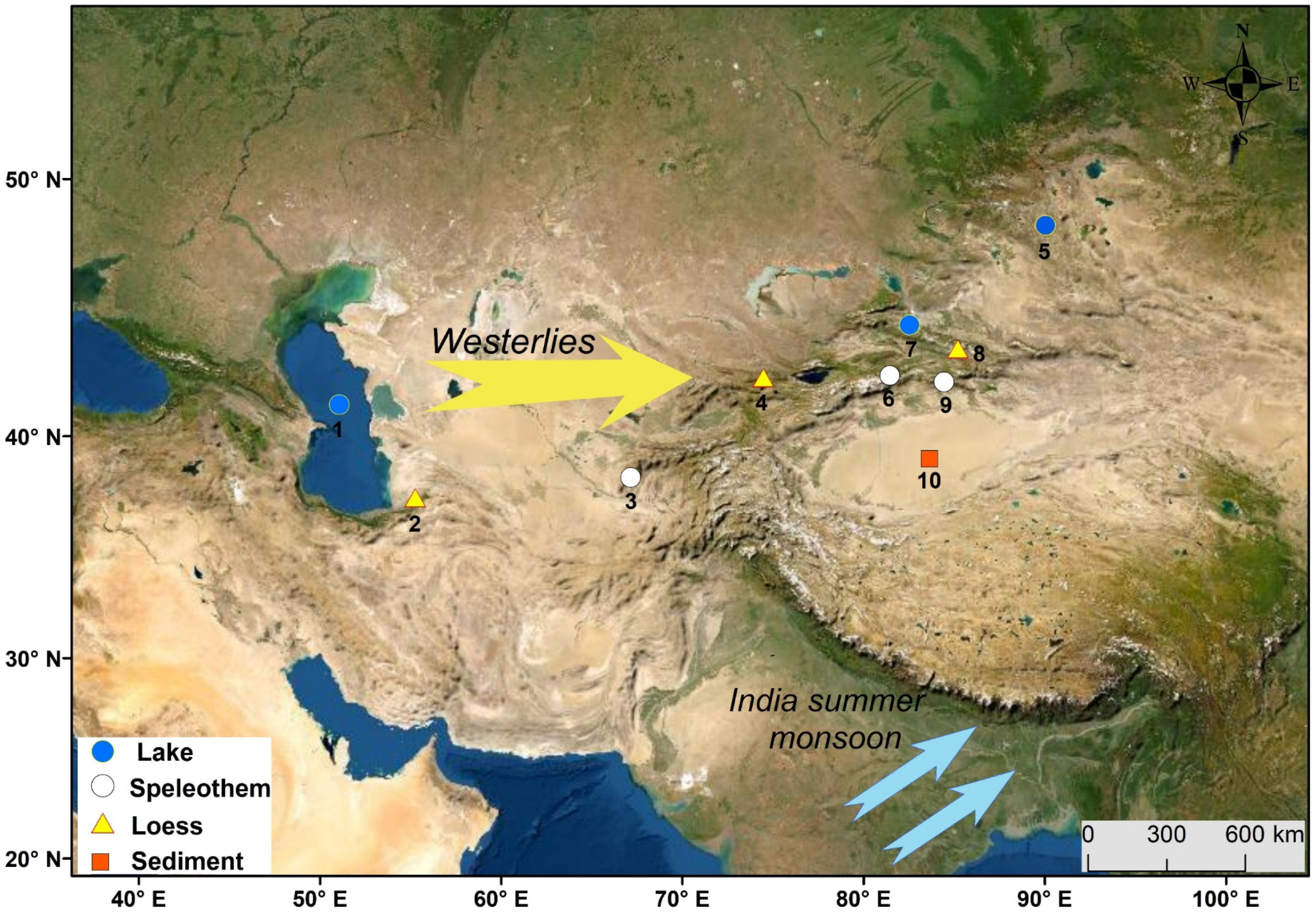
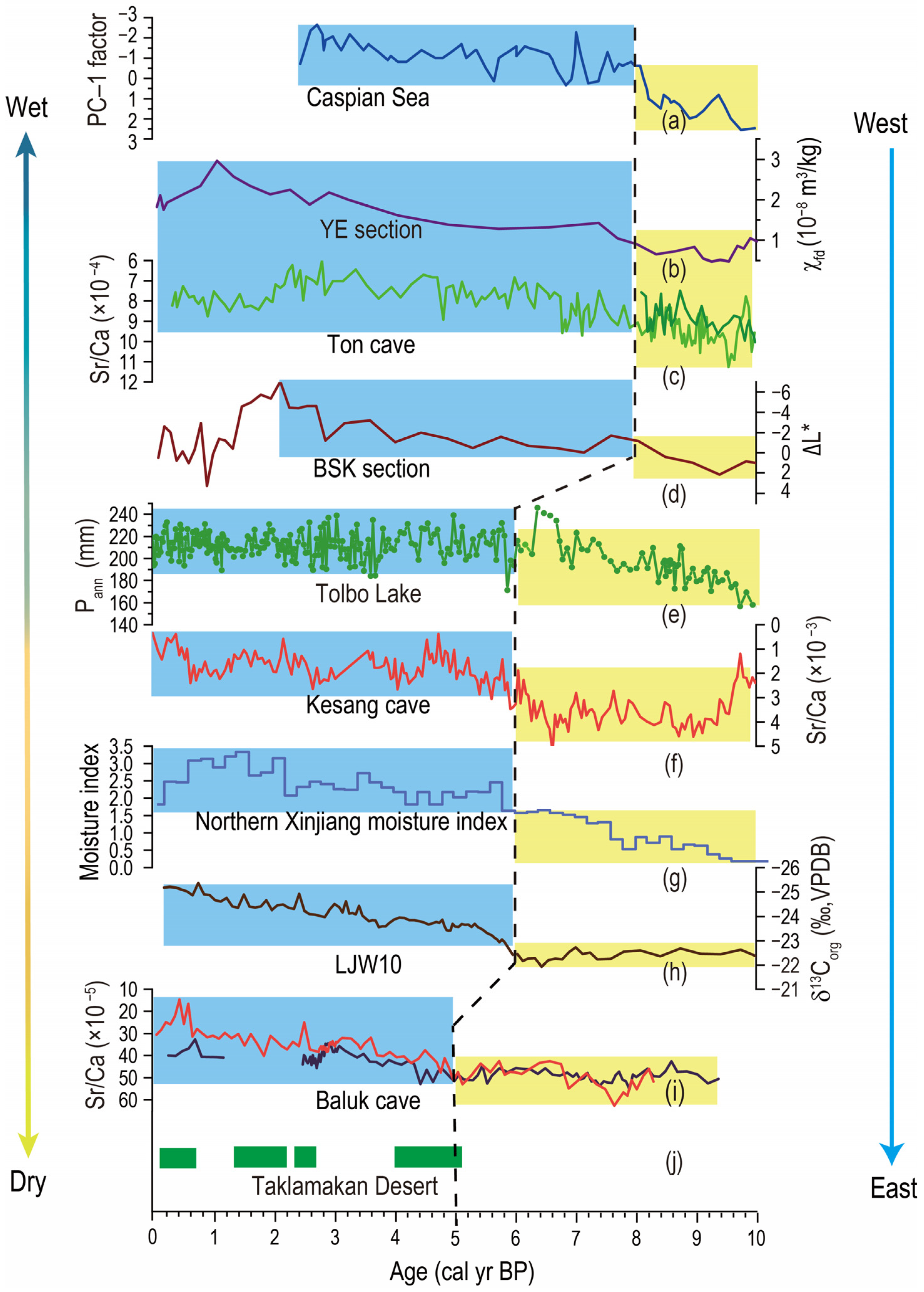
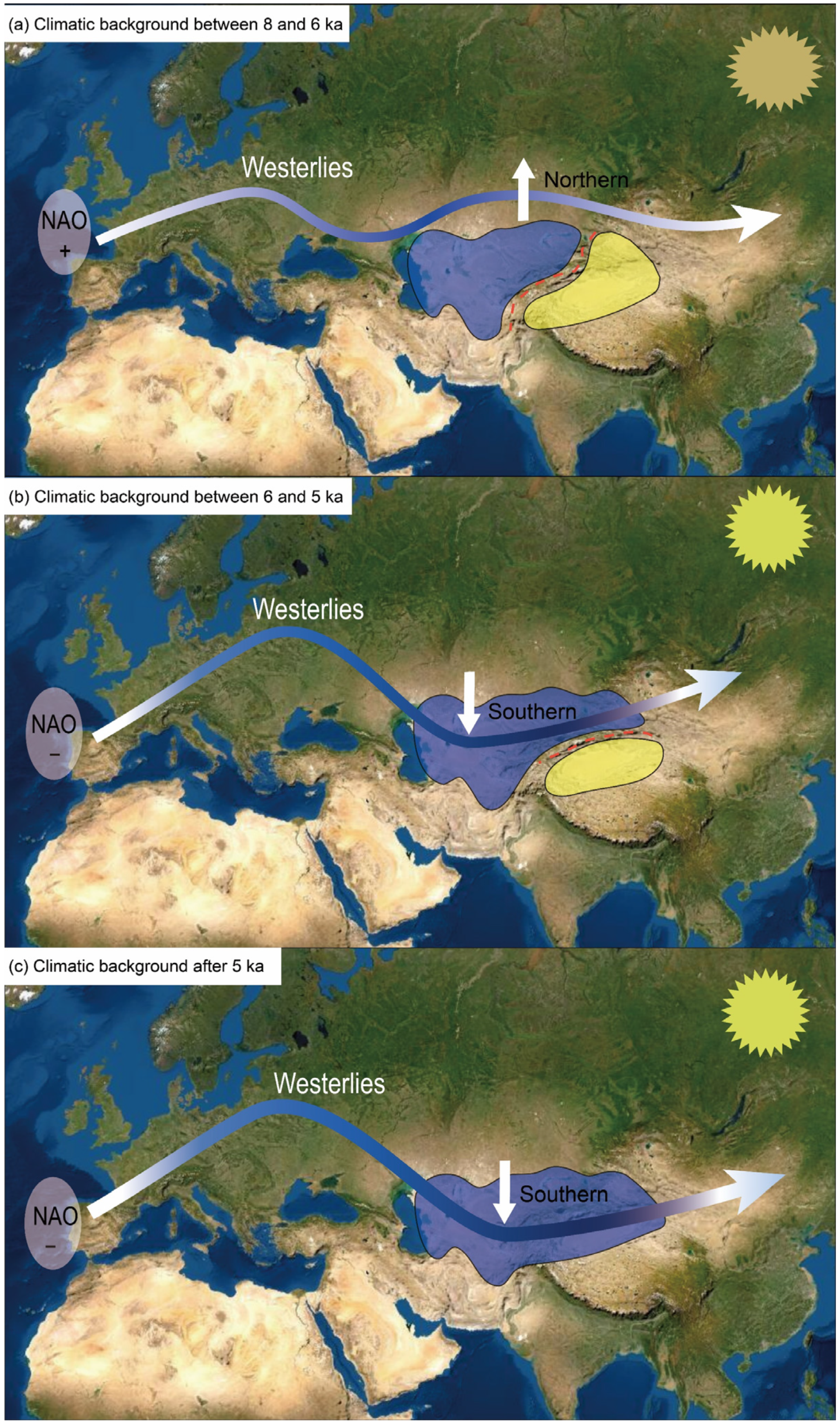
| NO | Site Name | Location of Sites | Log. (° E) | Lat. (° N) | Alt. (m) | Type of Sediment | Type of Proxy | Climatic Indication | Period (ka BP) | Resolution (yr) | Dating Method | Number of Dates | Number of Dates during the HCO | References |
|---|---|---|---|---|---|---|---|---|---|---|---|---|---|---|
| 1 | Caspian Sea | Caspian Sea | 41.55 | 51.10 | 26.5 | Lake | Pollen | Moisture | 12–2.4 | 110 | 14C | 4 | 2 | [37] |
| 2 | Yellibadragh (YE) section | NE Iran | 37.35 | 55.25 | 383 | Loess | χfd | Moisture/precipitation | 11.8–0 | 300 | OSL | 10 | 4 | [38] |
| 3 | Tonnel’naya (Ton) cave | Uzbekistan | 38.24 | 67.14 | 3226 | Speleothem | Sr/Ca ratio | Moisture/precipitation | 16–0 | 40 | 230Th | 16 | 8 | [39] |
| 4 | Bishkek (BSK) section | Kyrgyzstan | 42.42 | 74.46 | 1432 | Loess | Lightness | Moisture | 10–2 | 350 | 14C | 6 | 2 | [40] |
| 5 | Tolbo Lake | Altai Mountains | 48.33 | 90.03 | 2080 | Lake | Pollen | Annual precipitation | 13.7–0 | 30 | 14C | 17 | 8 | [36] |
| 6 | Kesang cave | Northern Xinjiang | 42.52 | 81.45 | 2000 | Speleothem | Sr/Ca ratio | Moisture/precipitation | 16–0 | 50 | 230Th | 17 | 6 | [39] |
| 7 | Northern Xinjiang moisture index | Northern Xinjiang | - | - | - | Lake | Multi-proxy | Synthesized moisture | 12–0 | - | - | - | - | [41] |
| 8 | Lujiaowan10 (LJW10) | Northern Xinjiang | 43.58 | 85.20 | 1462 | Loess | δ13Corg | Moisture | 12–0 | 100 | OSL | 7 | 5 | [42] |
| 9 | Baluk cave | Southern Xinjiang | 42.26 | 84.44 | 2752 | Speleothem | Sr/Ca ratio | Moisture/precipitation | 9.4–0 | 22.8 | 230Th | 19 | 12 | [28] |
| 10 | Taklamakan Desert | Southern Xinjiang | 39.04 | 83.64 | 1027 | Sedimentary sections | Sedimentary facies | Moisture | 10–0 | - | OSL | 19 | 10 | [43] |
Disclaimer/Publisher’s Note: The statements, opinions and data contained in all publications are solely those of the individual author(s) and contributor(s) and not of MDPI and/or the editor(s). MDPI and/or the editor(s) disclaim responsibility for any injury to people or property resulting from any ideas, methods, instructions or products referred to in the content. |
© 2024 by the authors. Licensee MDPI, Basel, Switzerland. This article is an open access article distributed under the terms and conditions of the Creative Commons Attribution (CC BY) license (https://creativecommons.org/licenses/by/4.0/).
Share and Cite
Wang, Z.; Liu, X.; Xie, H.; Chen, S.; Chen, J.; Wang, H.; Ma, M.; Chen, F. Time-Transgressive Onset of Holocene Climate Optimum in Arid Central Asia and Its Association with Cultural Exchanges. Land 2024, 13, 356. https://doi.org/10.3390/land13030356
Wang Z, Liu X, Xie H, Chen S, Chen J, Wang H, Ma M, Chen F. Time-Transgressive Onset of Holocene Climate Optimum in Arid Central Asia and Its Association with Cultural Exchanges. Land. 2024; 13(3):356. https://doi.org/10.3390/land13030356
Chicago/Turabian StyleWang, Zhen, Xiaokang Liu, Haichao Xie, Shengqian Chen, Jianhui Chen, Haipeng Wang, Meihong Ma, and Fahu Chen. 2024. "Time-Transgressive Onset of Holocene Climate Optimum in Arid Central Asia and Its Association with Cultural Exchanges" Land 13, no. 3: 356. https://doi.org/10.3390/land13030356
APA StyleWang, Z., Liu, X., Xie, H., Chen, S., Chen, J., Wang, H., Ma, M., & Chen, F. (2024). Time-Transgressive Onset of Holocene Climate Optimum in Arid Central Asia and Its Association with Cultural Exchanges. Land, 13(3), 356. https://doi.org/10.3390/land13030356






